Antonio Giacobazzi: "Gilles, the love of risks and the fine gotten at my house." On July 16, 1977 Villeneuve made his F1 debut. The memories of his sponsor at Ferrari, 35 years after his death. From our correspondent Marco Mensurati, 13 July 2017.
Silverstone. Last May 8, many of the Ferrari and F1 fans commemorated the 35 years of Gilles Villeneuve's death. But the Canadian driver would certainly have preferred to be remembered today and right here in Silverstone perhaps while, excited, he was putting on a Formula 1 helmet for the first time. Yes, because today, 40 years ago, Gilles Villeneuve landed on the F1 planet where he debuted, aboard a McLaren-Ford, on 16 July 1977, at the British Grand Prix. After that race, half a paddock was already in love with him. One in particular: Enzo Ferrari.

To remember those days is Antonio Giacobazzi, one of the protagonists of the exploit of Villeneuve in red as well as, through his winery, sponsor and personal friend. "Enzo Ferrari - he says - often frequented the cellar, came here and bought Lambrusco for himself and his friends. He came to taste the must, it often happened that he also gave us indications on how to do it; he liked it dry, clear and acidic. Then he spoke of cars and Formula 1. In those months he complained very often that Lauda obscured the role of Ferrari. "When he wins, Lauda wins, not Ferrari", he said. So when, a few months later, there was the break up with the Austrian, he had no doubts: "Villeneuve is going fast and nobody knows him!"
He was perfect.
"I still remember when he called me. I was here in the cellar. "Antonio run here, you have to do me a courtesy... I took this young Canadian. He needs a sponsor. You can't refuse.""
Could you do it?
"To say no to Ferrari was not easy. We immediately agreed and it was a very convenient agreement for them and for us."
What type of figure are we talking about?
"I don't think it's appropriate to say it. Let's say we are talking about a few million lire. But the relationship went far beyond that of sponsorship. We became friends and for this reason we honored the contract with the family even after his death.
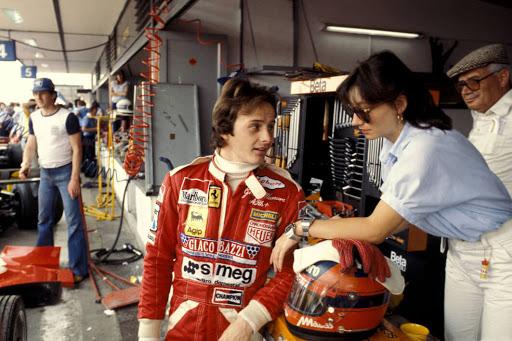
Gilles arrived in Italy from Canada with his wife and two children, the same age as mine. I had an old camper. He had a pick up with a roulotte attached. Our kids played together and, when they got tired of being around, they sneaked into the pits to watch the mechanics trafficking with the cars. Instead, he and I often met to talk."
What was he like?
"One day I asked him: Gilles, what are you doing when you are not around with F1? He told me that in Montecarlo, where he lived, he took the off-road vehicle and the family, went up to the mountains, got everyone out of the car, hooked the jeep with the cable anchored under the hood to a tree trunk and in reverse went down the cliff. So, hanging on the tree, he then tried to go up, helping himself with the winch. I was amazed. One day I returned to the topic: but are you sure of that pastime? Isn't what you risk at the weekend enough?"
Wasn't that enough?
"He replied that he needed it. That risking was not a job but a necessity. If he had found himself doing it just for work he would have stopped racing. They wrote a lot about him, for me he was more than anything else this: an explorer of his limits. Every one of his gestures was part of this challenge: parking too."
Even parking?
"He had a Ferrari 308. In theory red, in reality on the sides it was orange, so much he had consumed it running at full speed on the Montecarlo - Maranello road. And when he arrived in Maranello to park he didn't maneuver, no. He made a spin that ended with the car stuck between two others."
What memories do you have of Villeneuve's last days?
"I still have a fine at home which he got here in front with my Ferrari. He had come from Montecarlo by helicopter and asked me to borrow it. He went on errands, then we went to lunch together. Pironi was in the area. They were friends and he invited him, with Pironi there was a French friend of his, we also invited him and, while we were there, we told a few journalist friends. During lunch I discovered that Pironi's friend was a magician. So I said to him: "you who are a magician, tell me a little bit, who wins on Sunday in Imola?" He had no doubts and said: "Pironi". I don't know why but that answer affected everyone very much. Villeneuve too."
Then what happened?
"Gilles and Pironi had agreed to give a little show in front of the Italian public, they would have dueled a little and then they would have re-established positions. But, in the end, Pironi did not let him pass and crossed the finish line first. Villeneuve was furious. He didn't want to go to the podium. I forced him. He did go but he was bent and wasn't smiling. He went back to the camper and threw the plate they had given him as a prize. Then he left by helicopter, leaving on foot Pironi, who had come with him and no longer knew how to get home. I still have in front of my eyes Pironi's image in my camper, with the cup - which then he would have forgotten - desperate for the quarrel with his friend: "but why he got angry... It was a race...""
Was Villeneuve angry with Ferrari?
"He was expecting an intervention. But the old Enzo simply said: "the important thing is that a Ferrari has won.""
According to someone there was a connection with the accident in the qualifying of the next race...
"I don’t know. I still wonder too even today every time I look at that fine that my son found in the Ferrari dashboard, 30 years later."
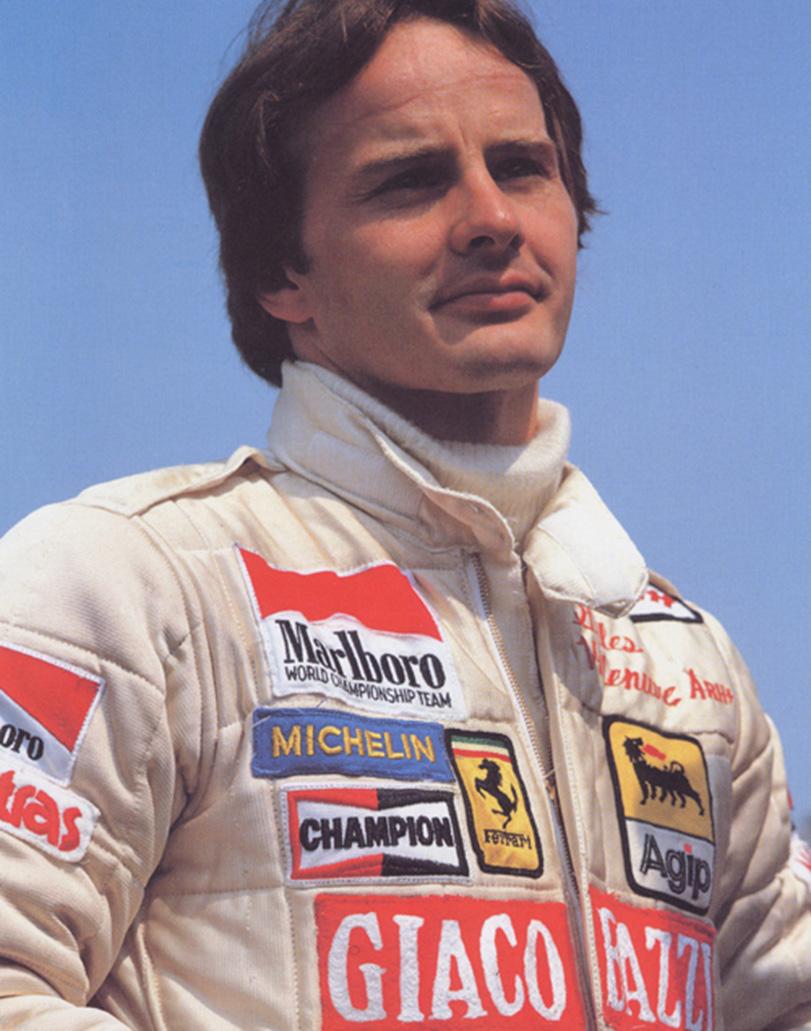
From Enzo Ferrari's call, the name Giacobazzi and the myth of Villeneuve are inextricably linked and the commercial return is enormous. Giacobazzi was placed everywhere in Formula 1: on the podiums, where you were toasting with Spumante Gran Premio and in the most spectacular points of the racetracks around the world.
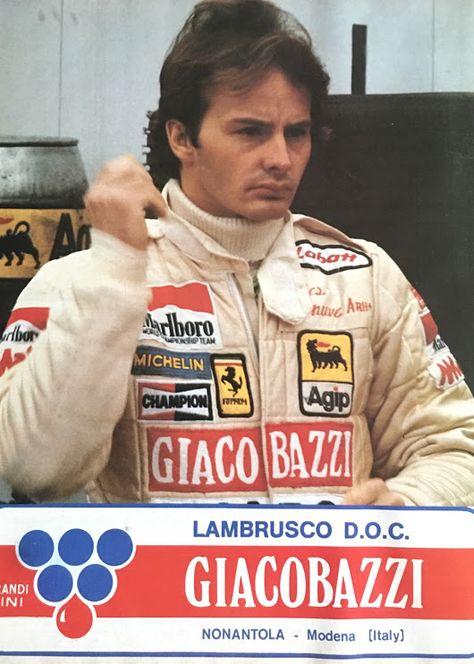
At Imola, in particular, Giacobazzi was at home and, even today, everyone remembers the very attractive models wandering around the pits with the Lambrusco team Giacobazzi uniform.
A sincere friendship is also born between the Villeneuve and Giacobazzi families. Antonio was one of the few close friends who was able to attend the rite of Gilles' cremation and his private funeral. The friendship between the families will never end and even Jacques, son of Gilles, at the beginning of his career will bear the name of Giacobazzi on his suit.
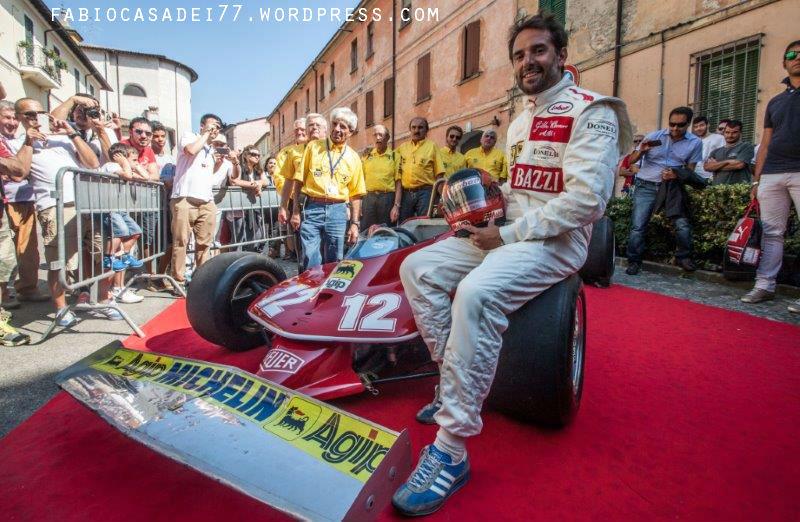
Today Gilles' car, the 1979 Ferrari T4, is located in the Giacobazzi family museum in Nonantola.
Jonathan Giacobazzi tells about his father Antonio - Gilles' first sponsor - and what was defined by Marcello Sabatini, then director of Autosprint, as "the Villeneuve fever". "Enzo Ferrari, summoned to his office in Maranello Gilles Villeneuve and my father, said to the latter:" Giacobazzi, you sell your wine in the United States, from today you have the possibility of being able to sell it also in Canada. This will be the new Ferrari driver." And my father, without even having heard of Villeneuve, first closed a sponsorship contract which then ended at the end of 1982. Villeneuve was genuine and direct and, if he said something to you, it was really what he thought. In Imola he intended to collect the credit acquired with Ferrari in 1979 for making spontaneously and willingly his partner Scheckter win the world championship with the 312 T4, despite having had the opportunity to win the title. Everyone in Ferrari and Gilles himself expected this. In 1980 there was an agreement in this sense with Scheckter but the T5 was not competitive and in 1981 the turbo engine was fantastic but the chassis was less good and therefore only exploits like Jarama and Montecarlo were allowed, not enough to win the championship. The victories of Monte Carlo and Jarama, however, remain in the anthology of F1 history. For Pironi, Imola was like the apple for Eva in the earthly paradise. And for Ferrari Villeneuve's notoriety was becoming really uncomfortable because now when he won he was the winner and not Ferrari. Ferrari didn’t like Lauda completely and his idol was Nuvolari. Ferrari really loved Gilles but he really only loved his collaborators, his mechanics, his workers, normal people. When someone's personal interest meant that his being a soloist dominated the image of Ferrari, for him the perspective changed. When Villeneuve sought comfort from Ferrari after Pironi's rudeness, the old man replied that however a Ferrari had won, thus not taking his defenses. At Imola in qualifying Villeneuve was two seconds faster than Pironi. Before the race Ferrari and Renault, given the few cars at the start and to avoid that there were not enough of them at the finish, agreed that, after an initial show for the public, with 10 laps to go they would freeze the positions of their cars so that there were no more overtaking. With 10 laps to go Villeneuve had a conspicuous advantage over Pironi when they displayed the “slow” sign from the pits. At that point Gilles slowed down by even 2 seconds per lap, so much so that Pironi then caught him and then the fantastic show that we know started. At the end of the race Gilles came to our hospitality van and, talking to my father, he repeated: "he stole my race, he stole my race." He didn't want to go on the podium and my father then insisted: "if you don't do it for yourself, do it for the fans." He went there and, when he went back down, he came back to the hospitality throwing the plate at my father saying: "I took this for you because mine was stolen from me." My father was unable to attend the next GP of Zolder and this was his great regret. In the two weeks before the Belgian GP Gilles, speaking with my father, asked if Giacobazzi's support would continue even if he had raced for another team. And my father replied diplomatically that he could still stay with Ferrari and follow him. Ferrari was so competitive that year that only episodes like Imola and Zolder prevented Villeneuve from winning the championship. He was alone in Zolder for the first time, not even his wife was able to attend due to the first communion of her daughter Melanie. Scaramelli, his mechanic, Forghieri, Gozzi, the all tell of a tense air inside the pits and that nothing was done to mitigate it. In the qualifying, on Friday, Villeneuve was easily ahead of Pironi in both heats. On Saturday, in qualifying, Pironi did an extraordinary lap time, bearing in mind that the car was not suited to the circuit and therefore had potential from fourth to fifth row. Villeneuve had no way to talk to anyone or to reason about this time and, although Forghieri had repeatedly tried to convince him not to go out on the track because having finished the sets of performing tires he had no hope of beating that time, he decided to go out with used tires. At that time, given that there were only two sets of tires available, the differences between the drivers on track in qualifying, although they all going flat out, was in the order of even 6 seconds. And that was the case between him and Mass. However, Gilles wouldn’t have done the time. Villeneuve's head had three impacts, front, side and rear and at that time the helmets weighed two kg, they did not have the protections of the current ones. So, in my opinion, he was already dead before he landed hitting the fence post. Apart from Pironi who raced for Ferrari, no other driver showed up at the hospital, demonstrating the cynicism of the time. Talking to my father and Joanna, who had traveled with him by helicopter at different times, they had told me episodes of impossible travels beyond all possible imagination. In December 1981 Gilles had just picked up the new helicopter, the new Agusta which he then only used for a few months and was flying with my father when a warning light came on. When asked by my father about what that light on was, he replied that it didn't mean anything, that it was one of those lights that light up in the utility cars and don't mean anything. Taking the instruction booklet, my father checked that it was the gas pump warning light instead. They miraculously managed to land in a service station alongside the highway. He didn't even notice, he was like that. Another episode told by Joanna that had amused her was when Gilles, flying during a windstorm, left the controls to prove the efficiency of a new technology, then at the dawn, with which the helicopter was equipped and which allowed the automatic flight in those conditions. For how he intended life, he was perhaps destined to end like this. His luck in bad luck is that he killed himself in a Ferrari which created the myth. If he had raced for another team, Mc Laren, Williams, it wouldn't have happened. Although he won small, if we compare his statistics to those of the drivers who raced with him with the same number of Grand Prixs, he won more than many others. At that time, even those who started twentieth could win the race. Gilles had already played a few jokers. The accident in Japan, similar in dynamics to that of Zolder, had left him alive by a miracle."
Two cars driven by Gilles. The first, the model of the Lancia Beta Montecarlo of the 1979 Giro d'Italia.
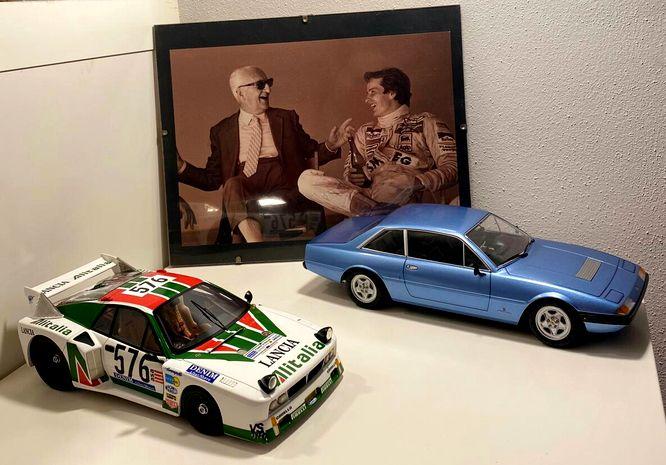
The second is the Ferrari 400 with which Gilles, at Imola on April 22, 1982 at 14:20, got the "famous" fine of twelve thousand lire by the traffic warden Roberto Mantovani.

The car, owned and driven by Enzo Ferrari, had been sold to Antonio Giacobazzi who willingly lent it to Villeneuve when, especially in 1981 and 1982, he went to Maranello with his helicopter.
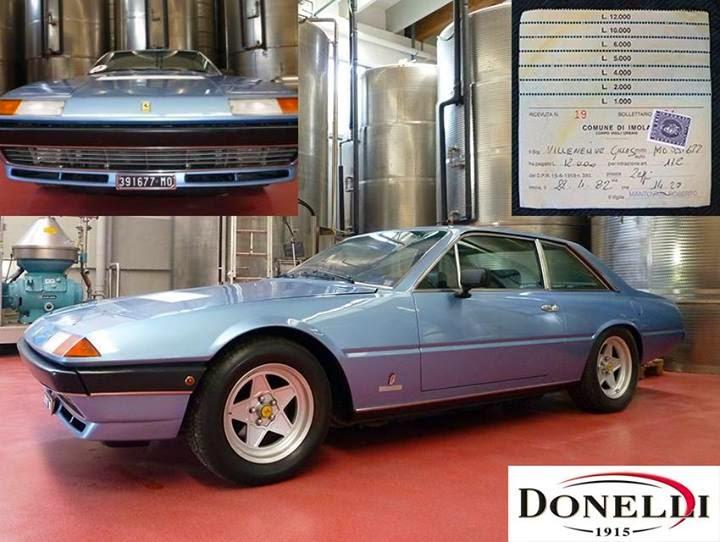
Currently the car is in full working order and is part of the "Donelli Collection".
The thirtieth anniversary of the tragic death of Gilles Villeneuve fell on 8 May and it was celebrated by Ferrari with a performance of his son Jacques on the Fiorano track. Villeneuve junior drove the 1979 Red, the T4, that is the single-seater with which his father finished the world championship second to his friend and teammate Jody Scheckter.
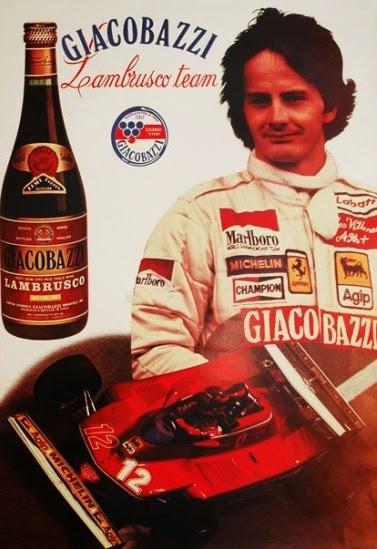
In addition, in Modena, at the Foro Boario, an exhibition dedicated to the little Canadian was inaugurated in the afternoon, an event set up especially thanks to the contribution of the Giacobazzi family. The Giacobazzi, Nonantola wine producers, linked their brand to Gilles at the suggestion of the Drake. The Giacobazzi family of Donelli Vini (Gattatico, Reggio Emilia) presented its collection dedicated to Gilles Villeneuve to the public for the first time. From Tuesday 8 May, exactly thirty years after the death of the famous Canadian driver, helmets, cars, suits and other memorabilia selected by Jonathan Giacobazzi have been exhibited at the Foro Boario in Modena.
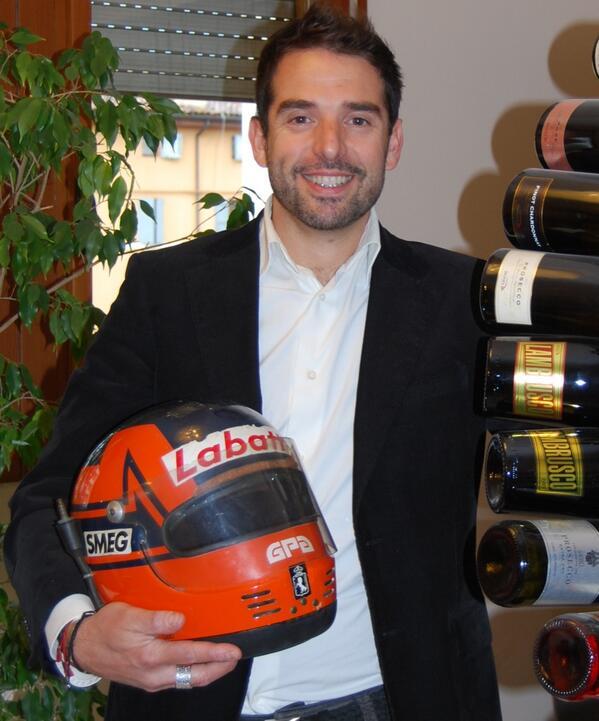
The exhibition "Gilles Villeneuve and his time" retraced the career of the driver through unique pieces such as the 1979 Ferrari 312 T4, with which the Canadian conquered three Grand Prixs and the 1981 Ferrari 126 C1, linked to the victories of Monte Carlo and Jarama; other items of great interest are the 1980 GPA helmet, the 1978-1979 suit with which he won the Kyalami and Long Beach GPs and the 1982 suit, the last one worn by Gilles.

The Giacobazzi family owns the largest collection in the world by number of memorabilia that belonged to Villeneuve. Jonathan Giacobazzi, creator and technical curator of the exhibition, commented on this passion: «I have always dedicated myself to Formula 1, also because of the support that my family gave to Villeneuve when he was racing for Ferrari. The relationship of esteem and affection that we established with Gilles allowed me to collect and preserve the objects that best represent him».
It was impossible to resist the contagion at that time. Villeneuve, with his explosive exuberance, expressed on the track what we, kids of the time, dreamed of witnessing in everyday life.
He won small. Almost nothing. He did not become world champion and he did not collect records. Therefore, the emotion that still arouses in people who participated in the chills he generated is almost psychoanalysis stuff.

One Sunday in July 1979, the former snowmobile driver invented the crazy duel with Rene Arnoux in Dijon, in a French Grand Prix. The scenes of the battle have become a collective heritage of the memory of many. Decades later, tell me, how many other 'wheel-to-wheel' performances have we enjoyed on F1 circuits? The answer is: none!
Do we want to talk about when, in 1981, Gilles won in Spain, in Jarama, keeping behind a pack of hungry pursuers, rejecting the assault curve after curve? It was a masterpiece of courage, it was a show of vigorous tenacity, it was a miracle of passion. In fact, Enzo Ferrari, in the aftermath of an unforgettable afternoon, dared to compare the little Canadian to Tazio Nuvolari. He had never dared such a combination. "I loved him," said the Drake, badly hit after the death of his acrobatic driver.
Villeneuve, having come from a dream, surrendered himself to the dreamlike beauty of the Myth on a sad afternoon of a gloomy spring. It was May 1982. Like many, like everyone else, we saw him die watching TV. It was as if, suddenly, someone had come to tell us that youth was a memory. To be archived.
Gilles the pure and a forever orphaned F1. He would have changed it. Forghieri: «but without ever being able to win the title.»Umberto Zapelloni, 18.01.2020.
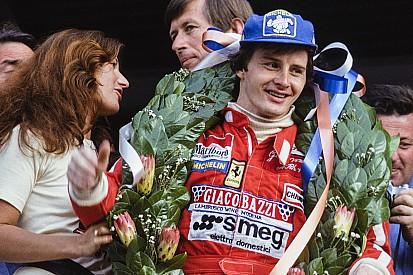
It is difficult, indeed impossible, to imagine Gilles Villeneuve at 70. You don't see him grandfather playing the trumpet for his grandchildren and challenging them to video games. Gilles will always remain a rebellious boy who left too soon from a world that he was thrilling with his crazy endeavors. Today he would probably be disqualified in all races. They would not let him duel wheel to wheel with Arnoux in Dijon, they would not allow him to do laps without a rear tire like in Zandvoort or with the front wing folded covering his view as in Canada. They would not let the Villeneuve fever, which also brought many people closer to Formula 1, rise. No, today Gilles could not do Gilles in a world where every risk must be calculated and possibly avoided. But Gilles was a pure, as always tells the engineer Forghieri, the technician who knew him best of all and who always repeats: «Gilles was a loyal man as well as a great driver. He was a force of nature but he was pure, he would never have become world champion because for him there was only the race he was doing, even at the cost of dying». Forghieri is probably right even if, in that damned 1982, a little would suffice for him to become champion with Ferrari. Without Imola's quarrel with his friend Pironi, without the blind fury that led him to die in Zolder, he would still be here and F1 would be a little different. With Gilles on track that world championship would not have gone to Keke Rosberg and who knows if there would have been Jacques and Nico, the heirs. Probably yes. Jacques grew up in the pits. When he got into the car, helicopter or boat with his dad, he shouted to him: "quicker Daddy, quicker", as some friends of Gilles and Jacques himself tell. It’s impressive to think that Gilles entered the heart by winning only six out of his 67 races between 1977 and 1982. His son has won 11 out of 163 becoming champion in Formula 1 and Formula Indy, but has never raced Gilles style, although he has always been a rebel, an opponent of the system intended as Ferrari and Schumacher. Today Jacques is one of the most sincere and appreciated television commentators. It would have been cool to have him and dad in the cabin. However, Gilles, without Zolder, would have probably found a Tamburello. He risked on the track, on the highway, at sea and in the sky. More than one of his colleagues refused to board his helicopter. Gilles was like that. This is why it is impossible to imagine him at 70. Just as it is impossible not to have him in your heart.
“I have never tried to walk in his shadow or to beat him”, Jacques Villeneuve said. “I can’t imagine my father getting old because he needed to be on the edge all the time.”
Joanna Villeneuve said: “I was involved in racing for many, many years without ever it wanted to be my favourite pastime. You know when you love someone, especially when you are sixteen you madly love, you do anything, so you just get interested in it. And it does become part of your life.”
Nigel Roebuck, a race journalist, said about Gilles: “In 1976 James Hunt has been burnt off by Gilles. “This kid has got to be in Formula 1”, James said. Watching a test before the Grand Prix I remember I have never, never seen anybody driving a Formula 1 car first time like that.”
“He had his own style, that someone almost abandoned but everyone loved that because he drove with his hearth.” Mario Andretti.
“I heard about his spectacular career on snowmobiles. I also heard glowing accounts of his courage. When I was introduced to this tiny Canadian, this minuscule bundle of nerves whom I compared in his physical structure to the great Nuvolari, I said to myself “let’s give him a try.”” Enzo Ferrari.
Gaston Parent his manager said: “I had a letter of intent. When we got serious about it, my secretary made a letter and eventually we would sign a contract. We never did. After a while I got to know Gilles I figured I don’t need a contract with him. He had my word and I had his.”
“What happened in Imola was the most hateful thing I have seen.” Pino Allievi.
Giancarlo Giacobazzi said: “when Gilles passed away, Enzo Ferrari suffered a lot. Villeneuve willingly ate Modena dishes, tortellini, boiled, zampone. But he went easy on the wine because he said: "if you drink a lot, you go slow". When we went out for a drink the kids attacked him for autographs and not Scheckter, who got very angry because he said: "I'm the world champion!" Scheckter and Villeneuve both lived in Monte Carlo and made the Modena - Monte Carlo little challenges. One day they didn’t do very well, in Parma they got caught and the traffic police took them to the police station. It was night because these races took place after the tests generally. Gilles called all over Italy because they didn't let them out and then called me too. The situation was unlocked but they still made their little challenge to return to Monte Carlo. Today drivers all score points, they don’t enthuse anymore. When Gilles finished second he said: "it doesn’t count”. The sports world was clean, spontaneous, now it is less spontaneous, it is made of billions."
Don Sergio Mantovani said: “Villeneuve was like a son to me. When Gilles died, many Ferrari clubs promoted the dedication of a room in his honor and so we did. And, every May 1st, we remember Gilles Villeneuve and other drivers here. Old mechanics come, Joanna and Melany came.”
A new documentary maintains the legend of Gilles Villeneuve. June 12, 2020.
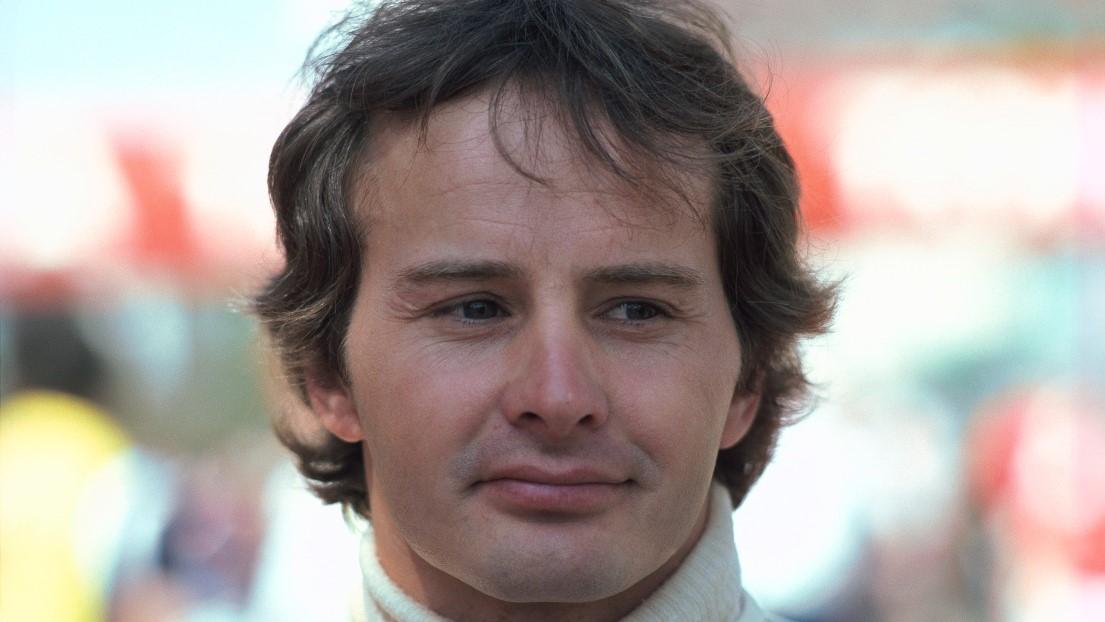
Gilles Villeneuve. Photo by Getty.
Montreal. Thirty-eight years after his tragic death, the legend of Gilles Villeneuve cannot be denied. His magic behind the wheel of the Ferrari continues to fuel memorable memories of a time when the driver alone could make a difference in Formula 1.
The nostalgics and the youngest will once again be able to appreciate the career of the one who has been affectionately nicknamed the 'Little Prince' in the new documentary 'Gilles Villeneuve: at full speed', a tribute initiated by producer Stephan Gabriele.
Since his death on May 8, 1982, during qualifying for the Belgian Grand Prix, Villeneuve has been the subject of several biographies, reports and other documentaries. Gabriele, for whom the driver from Berthierville was the childhood hero, this time gathered unpublished testimonies and archives never before shown on television.
This documentary has been broadcasted on ICI Radio-Canada Télé.
It traces the career of an exceptional driver, from his snowmobile races to his ascent to the top of motor racing with the most legendary of teams, Ferrari.
More than the sequences of his tour de force on the track, Mr. Gabriele's work makes it possible to realize that Villeneuve has left an indelible remembrance in the memory of those who rubbed shoulders with him closely.
A must, the duel between Villeneuve and René Arnoux during the last laps of an anthology race at the Grand Prix de France, in July 1979, on the Dijon-Prenois circuit, still thrills those who have witnessed it.
"This is one of the most exciting arrivals of all time that I have ever seen in Formula 1 or in which I have been involved," recalls triple world champion Jackie Steward in the documentary.
For more than five laps, the two drivers had duelled several times, sometimes driving side by side and the two cars were touching each other seven times. The Quebecer finally had the last word, completing the race in second place behind the winner Jean-Pierre Jabouille.
In addition to Stewart, Jody Scheckter, Villeneuve's teammate at Ferrari, Arnoux and Jacques Laffite, former F1 drivers, as well as Brenda Vernor, assistant to Enzo Ferrari, also recount their memories and the memorable moments of Villeneuve's career.
It’s a documentary filmmaker from Ottawa, Stephan Gabriele, who had the idea of reviving the memory of the Canadian driver who had a too short career in the highest spheres of motor racing.
Thirty-eight years have passed since the accident that costed him his life during a qualifying session for the Belgian Grand Prix.
"Since I was very young, I have always loved cars. Gilles Villeneuve, he was my childhood hero. All my friends wanted to look like Guy Lafleur. I wanted to be Villeneuve. The others always looked at me a little surprised," he explained earlier this week during a telephone interview.
However, Mr. Gabriele was not the only fan of the driver who shone in the Ferrari team.
In the early 1980s, in a world without the Internet, Quebecers had three great sports heroes.
There were Lafleur, Villeneuve and Gary Carter.
“Lafleur shone on the North American scene. Hockey was in our DNA. At that time, the Expos were as popular as the Canadians. We loved Carter because he was an American who had fallen in love with Quebec himself," Gabriele said.
"Gilles was the one who made Quebec resonate abroad. He had no contacts. He had no money. All he had was his talent. When he arrived in Formula 1, he was simply more talented than the others. Ferrari made an exception for him. This team was not used to hiring recruits. It wasn’t nothing."
Lafleur and Carter still occupy a certain space in the collective imagination.
Gabriele is a little under the impression that the new generation knows Villeneuve a little less.
“Gilles died 36 years ago. It's been a third of a century. You can hardly blame people who were born after 1982 for not knowing him.”
"People know that Gilles Villeneuve is a man who gave his name to a track. Me, I want to make this guy better known. I wanted to raise his profile."
To tell his story, the documentary filmmaker and his team interviewed 14 people who rubbed shoulders with Villeneuve during his career. They went to meet them in United Kingdom, France, Switzerland and Italy.
They allowed former pilots, journalists and team managers to tell - with surprising precision - old stories.
Only one other Canadian documentary has been devoted to the career and life of the champion. “Formula Villeneuve” first appeared in 1983.
Watching the new film, you realize that the film crew made the trip at the right time. The people who worked in the racing world at that time are now over 70 years old.
“It is often said that “timing is everything”. I would say it had to be done right now. These people have been very generous, but in a few years they may not want to be in front of the cameras.”
One of the speakers, commentator Jean-Louis Moncet, explains that Gilles Villeneuve took part in 67 Grand Prix. “We could get 67 anecdotes from these Grand Prix. Each time, Gilles found a way to be talked about.”
This is the problem with documentaries. At full speed lives up to its name. In 52 minutes, you just touch the - many - highlights of his career.
This is why Stephan Gabriele would eventually like to produce a longer version of his documentary, in English, intended for the international market. He would like this project to culminate in 2022, to mark the 40th anniversary of the death of Gilles Villeneuve.

SOME IMPORTANT DATES
Even if it was short, Gilles Villeneuve's racing career was punctuated by many highlights. Here are some of those that we revisit in the documentary “At full speed”.
1976: first championship
Villeneuve's debut in the Atlantic Formula was not particularly easy. In 1974, during one of his first races, he was involved in an accident and suffered a fractured left leg. He returned to competition the following year. In 1976, his talent took over. He won nine out of 10 races and became champion for the very first time.
1977: a test at McLaren
Due to the fact he continues to be successful in Formula Atlantic, Villeneuve gets his first opportunity to race in F1. At the wheel of the third car of the McLaren team, at the time of the British Grand Prix, he managed to obtain an 11th position. Failing to obtain a longer-term contract with the English, he was recruited by Ferrari, where he completed the season.
1978: prophet in his country
A few months earlier, it was announced that the Canadian Grand Prix was permanently relocated to Notre Dame Island, in Montreal. Villeneuve, a young driver on the rise, got his first Formula One win behind the wheel of his number 27 Ferrari.
1979: so close to the goal
Towards the end of a particularly exciting season, Villeneuve narrowly misses the world championship. He conceded the victory to his Ferrari teammate, the South African Jody Scheckter.
1982: the end at Zolder
Villeneuve enters the Belgian Grand Prix in a bad mood. An accident in qualifying costs him his life.
Videos
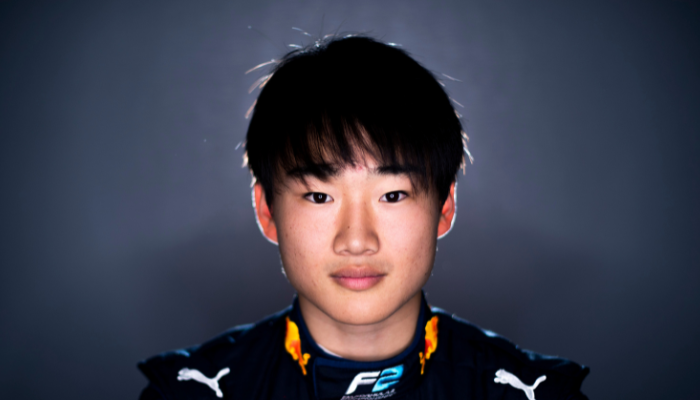
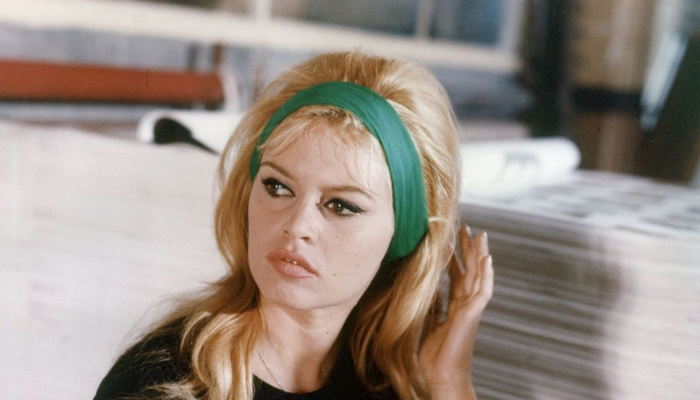
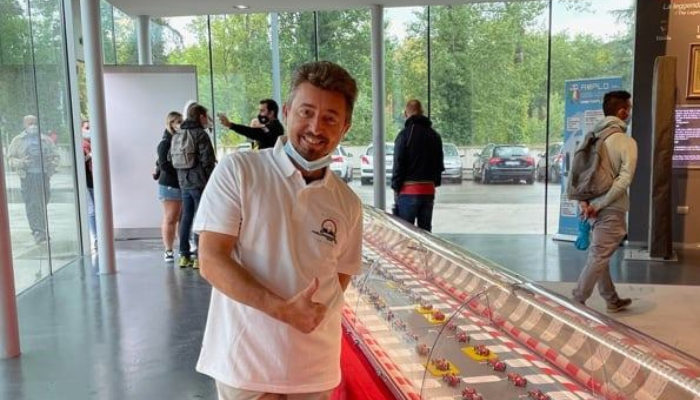
Comments
Authorize to comment